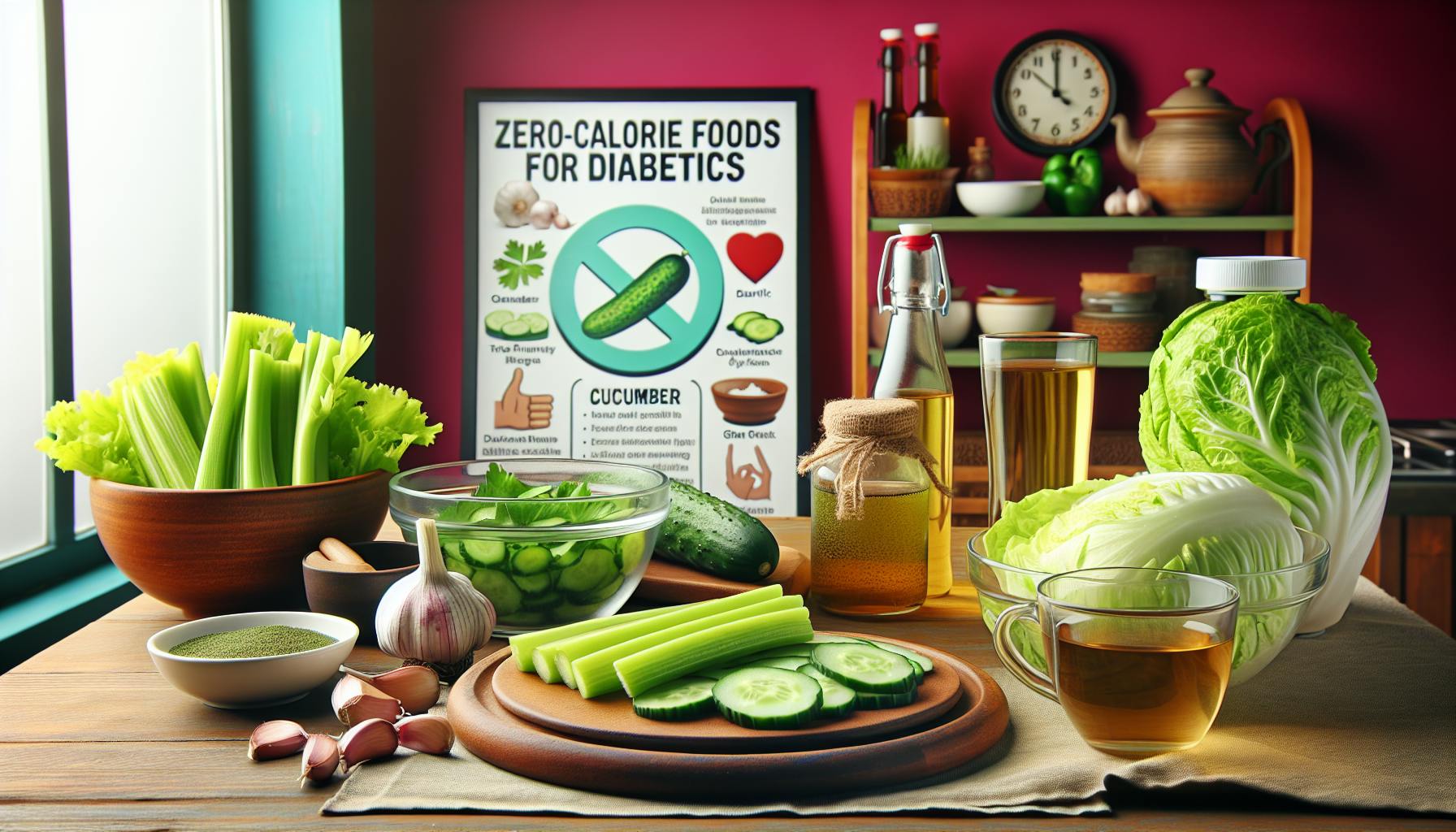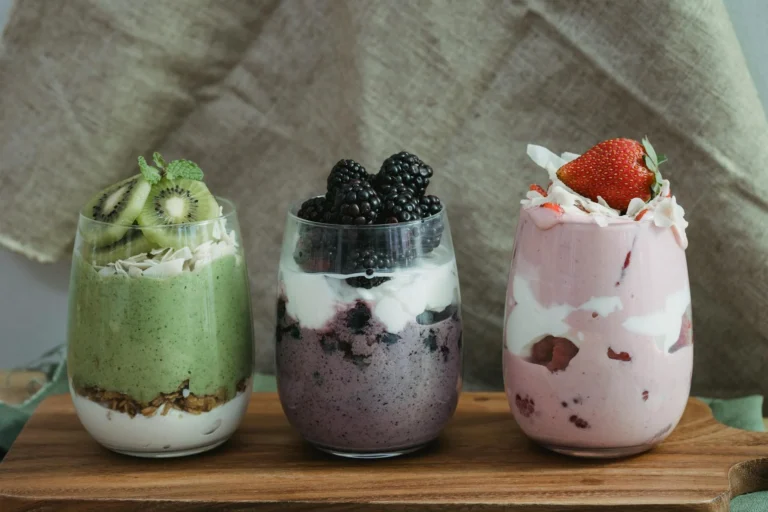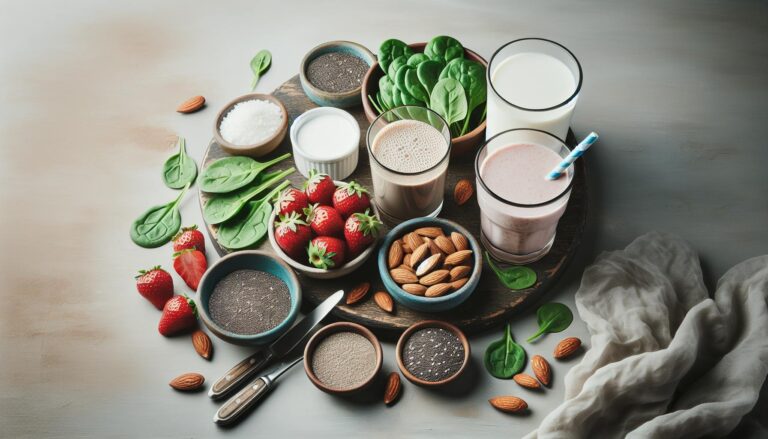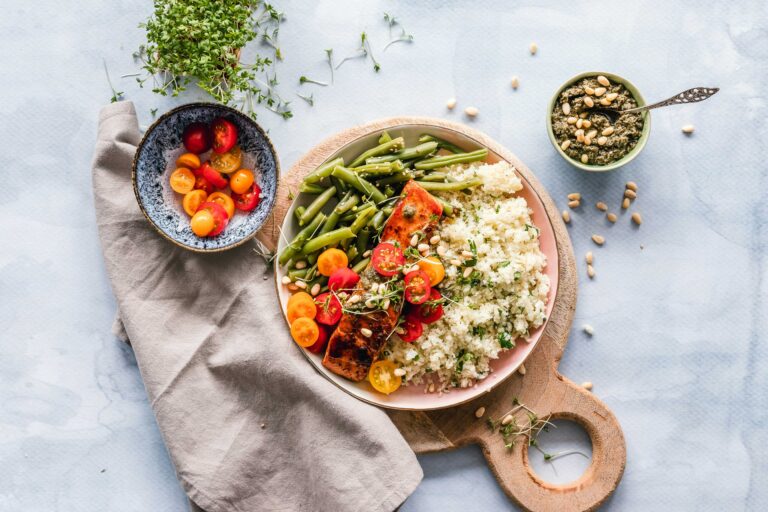Dine Smart, Stay Strong: Zero Calorie Foods for Diabetics
Discover zero calorie foods for diabetics! Find sweeteners, smart desserts, and healthy choices to manage your diabetes.
Zero Calorie Foods for Diabetics
Eating the right stuff is key to keeping diabetes in check. Zero-calorie foods, like those packed with artificial sweeteners and sugar alcohols, can help manage blood sugar levels. Let’s take a closer look at how these options can fit into a diabetic-friendly lifestyle.
Understanding Artificial Sweeteners
Sugar swaps, better known as artificial sweeteners, bring the sweetness without the carbs and calories. They won’t mess with your blood sugar, making them a go-to for folks watching their glucose (Mayo Clinic).
Here’s the sweet lineup:
- Aspartame
- Saccharin
- Stevia
These sweeteners pack so much punch that just a smidge does the trick. That means fewer calories than sugary alternatives, earning them a spot in the diabetic pantry. But hey, remember, just because a food’s low-calorie doesn’t mean it can’t still nudge your blood sugar up a bit (source).
| Artificial Sweetener | Sweetness Compared to Sugar | Caloric Content |
|---|---|---|
| Aspartame | 200x | ~0 calories |
| Saccharin | 300-400x | ~0 calories |
| Stevia | 50-300x | ~0 calories |
While the health world chats about artificial sweeteners’ pros and cons, the general consensus is they don’t mess with your blood sugar or insulin too much. More detective work is needed on long-term effects (Healthline).
Looking for diabetic-friendly snacks? Check out our pages: diabetic-friendly zero calorie snacks and low-carb diabetic snacks.
Impact of Sugar Alcohols
Sugar alcohols are another sweet option that won’t rock your blood sugar boat too hard. You might run into:
- Erythritol
- Xylitol
- Sorbitol
Unlike the artificial fellas, sugar alcohols have a bit of caloric baggage but still play nice with blood sugar.
| Sugar Alcohol | Calories Per Gram | Impact on Blood Sugar |
|---|---|---|
| Erythritol | 0.2 | Minimal |
| Xylitol | 2.4 | Low |
| Sorbitol | 2.6 | Low |
While easy on the glucose, sugar alcohols sometimes aren’t so gentle on your gut—a bit too much can leave you feeling bloated or worse. So, moderation is your friend.
You’ll find these in “sugar-free” or “no sugar added” labels, making them handy for those sweet cravings without the sugar spike.
For more insight, swing by our page on sugar-free foods for diabetics.
By getting a grip on artificial sweeteners and sugar alcohols, we can make smarter food picks that align with diabetes management. These zero-calorie options let us enjoy sweetness without the blood sugar backlash, making them a useful tool in a balanced diabetic diet.
Mindful Dessert Choices
Managing diabetes means keeping an eye on what we munch, especially when our sweet tooth is itching for a treat. The key here? Making wise choices so we enjoy desserts without the sugar havoc.
Portion Control for Type 2 Diabetes
Now, if we’re chatting about type 2 diabetes, we gotta keep it real with portion sizes and how often we dive into dessert land. Even if it’s zero calorie foods, too much for diabetics can mess with our blood sugar groove. So let’s keep those portions in check:
| Food Item | Portion Size | Calories |
|---|---|---|
| Sugar-Free Gelatin | 1/2 cup | 10 |
| Fresh Strawberries | 1 cup | 50 |
| Greek Yogurt (unsweetened) | 1 cup | 100 |
| Small Apple Slices | 1 small apple | 77 |
Think of these as small bites of delight in our daily diet. A sprinkle of balance, a dash of moderation, and we’re on our way to managing diabetes with ease.
Low Calorie Dessert Options
Lucky for us, there’s a buffet of low-calorie options that keep our taste buds happy without the sugar rush. Check these out:
- Sugar-Free Gelatin: This little number can hit the sweet spot without messing up the sugar meter.
- Fresh Fruit Salad: Whip up a fruit salad, skip the sugar sprinkle. Opt for berries and apples – they’re the cooler fruit kids on the block (Medical News Today).
- Greek Yogurt with Berries: Creamy Greek yogurt and berries make a dreamy combo that’s easy on the calories.
- Sugar-Free Popsicles: Cool down with pops made from natural sweeteners like stevia – sugar-free and good to go.
Feel like exploring more? Check out our guide on low-calorie snacks for diabetics.
Choosing smart sugar swaps like aspartame, saccharin, and stevia means we can treat ourselves while keeping diabetes at bay (source). Peek at those labels and pick desserts that match our flavor style and health vibe.
Need more helpful tips on sugar-free eats that are sugar-smart? Swing by our article on sugar-free foods for diabetics and dig into a world of diabetic-friendly zero calorie snacks.
Smart Sugar Substitutes
Who knew finding a sweet fix without dipping into unwanted sugar highs could be as simple as a switch? For those of us managing diabetes, zero-calorie treats like smart sugar substitutes let us savor that needed sweetness without piling on the calories or sending blood sugar levels sky high.
Aspartame, Saccharin, Stevia
In the ever-popular realm of sugar swaps, aspartame, saccharin, and stevia top the favorites list. These sweeteners are valued for their minimal impact on blood sugar, which means we can enjoy a hint of sugar without a side of worry.
- Aspartame: The go-to in diet drinks and sugarless gum, aspartame is a sugar stand-in that’s 200 times sweeter than the real deal—with none of the calories that come with sugar.
- Saccharin: This old-timer in the world of sweet treats comes in packets at your local coffee joint and packs 300-400 times the sweetness of sugar.
- Stevia: Plucked from Stevia rebaudiana leaves, this green thumb-approved option sweetens up desserts and drinks to 300 times the sugary oomph without tickling the calorie count.
Steering towards these sweeteners not only cuts back on those pesky calories but also keeps the dentist at bay by reducing tooth decay chances (source).
| Sweetener | Sweetness level (compared to sugar) | Calories |
|---|---|---|
| Aspartame | 200x | 0 |
| Saccharin | 300-400x | 0 |
| Stevia | 300x | 0 |
Blood Sugar Management
Swapping sugar for zero-calorie sweeteners offers a handy trick for managing blood sugar levels. Unlike the quick rise and crash of regular sugar, artificial options let us keep a steady hand on our glucose game (source).
With sweeteners like aspartame, saccharin, or stevia, diabetics can satisfy sugar cravings, making life a little sweeter without the guilt trip. The Mayo Clinic even gives them a nod, pointing out that these substitutes go a long way with just a pinch, keeping the calorie clock ticking slowly.
Choosing sugar-free gives us a mix-and-match freedom for meal planning, letting us sprinkle sweetness into things without the usual fear of glucose spikes. This is especially handy when whipping up low-calorie snacks for diabetics or munching on diabetic-friendly zero calorie snack foods.
So, next time we’re pining for something sweet, these sugar stand-ins can let us have our sweetness while our blood sugar stays cool and steady. Aspartame, saccharin, and stevia aren’t just zero-calorie helpers—they’re our secret sidekicks in diabetes management.
Strategic Dietary Choices
Alright, folks, when it comes to keeping diabetes in check, what we toss on our plates plays a major role. Let’s chat about how we can tweak our carbs and spice up life with some groovy grain swaps.
Managing Carbohydrate Intake
Carbs pull a fast one on our blood sugar levels, so we’ve gotta keep an eye on ’em. Figuring out which munchies are low-carb gives us the upper hand in making smarter eating choices.
Key Nuggets to Remember:
- Artificial sweeteners like aspartame, saccharin, and stevia are the real MVPs—they don’t mess with our blood glucose levels. You can think of them as free passes in the food game (MC, MNT).
- Ditch the white stuff like white bread, pasta, and rice—these guys are behind the sugar rollercoaster in our bodies (source).
| Food Type | Carbohydrates (g per serving) |
|---|---|
| White Bread (1 slice) | 15 |
| White Rice (1 cup) | 45 |
| Whole Grain Bread (1 slice) | 12 |
| Quinoa (1 cup) | 39 |
| Stevia (1 packet) | 0 |
For an in-depth look at low-carb munchies, check out low-calorie snacks for diabetics.
Healthy Grain Alternatives
Bringing healthy grains to our meals helps us play it cool with carbs and keep sugar in check.
Groovy Grain Picks:
- Whole Grains: Time to swap those whites for brown goodness like brown rice and whole grain pasta. They pack more fiber, which plays nice with our sugar levels.
- Quinoa: This snazzy, nutrient-rich grain keeps the carbs low and throws in extra protein and fiber vibes.
- Barley and Buckwheat: Perfect for keeping blood sugar steady Freddy.
| Grain Type | Carbohydrates (g per serving) | Protein (g per serving) | Fiber (g per serving) |
|---|---|---|---|
| Brown Rice (1 cup) | 45 | 5 | 3.5 |
| Quinoa (1 cup) | 39 | 8 | 5 |
| Barley (1 cup, cooked) | 44 | 3.5 | 6 |
| Buckwheat (1 cup, cooked) | 33 | 6 | 5 |
Opting for these goodies can put us on the path to managing carbohydrate intake while keeping our meals far from boring.
With savvy food picks, we’re all set to ride the smooth wave of balanced blood sugar and chow down on a diet that’s both exciting and wholesome. Got a craving for more tips or snack ideas? Dive into healthy snacks for diabetic patients.
Nutrient-Rich Options
Eating foods loaded with good stuff is a no-brainer for tackling diabetes head-on. Here, we’re talking about two superstar foods: avocados and eggs.
Avocados and Diabetes
Who doesn’t love a good avo toast? Avocados are a top choice for a diet that’s kind to blood sugar. They’re low on sugar — less than 1 gram, packed with fiber, and loaded with healthy fats. What’s not to love? Fewer carbs mean they won’t spike your sugar, making them perfect for keeping things steady.
| What’s Inside | Amount per 100g |
|---|---|
| Sugar | < 1g |
| Carbs | 9g |
| Fiber | 7g |
| Fats | 15g |
Turns out, eating avocados often might even help shed a few pounds and lower BMI. Those monounsaturated fats are like little helpers for improving cholesterol, giving your heart some extra TLC.
For the inside scoop on sugar-free foods fit for diabetics, wander over to our detailed zero-calorie food guides.
Benefits of Eggs
Eggs are like the Swiss army knife of food — always handy, always versatile. Apart from being incredibly tasty and filling, eggs can help cut down on heart disease risk, tune up insulin response, and boost that good ol’ HDL cholesterol.
| What’s Inside | Amount per 100g |
|---|---|
| Protein | 13g |
| Fats | 10g |
| Carbs | 1.1g |
Eggs bring a whole lot of protein and essential vitamins to the table. Plus, you can have them for breakfast, lunch, or dinner without getting bored. Omelet, anyone?
If you’re after more healthy snack ideas for diabetics, swing by for some more mouth-watering ideas.
Adding nutrient-powerhouses like avocados and eggs to your meal plan can help manage diabetes while making sure you’re getting the vitamins you need. For more ideas on low-calorie snacks for diabetics, we’ve got plenty of tasty options to explore.
Effective Protein Sources
Let’s talk about how we can make smarter food choices, especially for folks managing diabetes. Protein is our friend here—it not only curbs those pesky hunger pangs but also helps keep blood sugar levels in check. We’re going to dive into why Greek yogurt and legumes deserve to be on our plates.
Benefits of Greek Yogurt
Greek yogurt ain’t just your average dairy snack—it’s like the superhero of the yogurt world. Some studies suggest it might even slash the risk of developing type 2 diabetes by 18% (source). It’s crammed with calcium and quality protein, plus a little something called conjugated linoleic acid (CLA), all working together to keep us full and our bodies in better shape.
| Nutritional Content | Amount (per 6 oz) |
|---|---|
| Calories | 100 |
| Protein | 10g |
| Calcium | 110mg |
| Fat | 0g |
| Carbohydrates | 7g |
With its nutrient-packed goodness, Greek yogurt can be a filling, low-calorie option that’ll keep us from raiding the fridge again too soon. Try adding it to your stash of healthy snacks for diabetic patients.
Legumes for Blood Sugar Control
Let’s not forget about beans and other legumes if we’re aiming to keep blood sugar levels smooth. Rich in B vitamins, loaded with vital minerals, and oh-so-fibery, legumes also boast a low glycemic index—making them prime candidates for blood sugar control. Research shows that those who chow down on legumes could cut their risk of developing type 2 diabetes (source).
| Nutritional Content | Amount (per 1 cup cooked) |
|---|---|
| Calories | 230 |
| Protein | 15g |
| Fiber | 15g |
| B Vitamins | Lots |
| Glycemic Index | Low |
Beans can give our diet an essential nutrient boost while keeping those glucose levels steady. Consider popping them into your rotation of low-calorie snacks for diabetics.
By loading up on powerhouses like Greek yogurt and legumes, we’re not just following the good sense mom tried to instill, but we’re also supporting our blood sugar game plan while digging into tasty grub. For even more inspiration, check out our guide to sugar-free foods for diabetics and other healthy munchies.








Leave a Reply